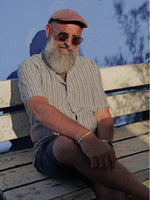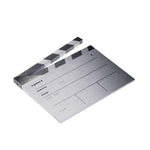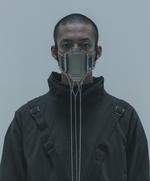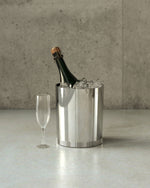20.09.23 in ambassadeurs
nicolas lefebvre


Nicolas Lefebvre is a French sculptor, known in particular for his mother goddesses, these assemblages of ancient objects and elements thought of as a dialogue between different civilizations and eras. his work is in line with the surrealists like miro. nicolas lefebvre will present a solo show for the masterpiece london art fair in june, with the tristan hoare gallery.
How do you present yourself when you talk about yourself and your job?
I assemble ancient objects from different civilizations and different periods. I allow myself to bring these objects into dialogue in a more natural way. I try not to distort them. I try to keep the primary meaning of the object and generally assemble it into a trinity of objects. I work a lot on the symbol of the cross of life that we find in Egypt, and almost everywhere in different civilizations.
I called my work Mother Goddesses over 20 years ago. That’s kind of my guideline. I make small pieces and very large pieces that are all unique, but they all have this one thing in common which is this cross with a circle on it.
I define myself as an artist, as a sculptor and as an assembler too. an assembler because ultimately, it is the continuation of the surrealists, with the ready-made of Marcel Duchamp. all the surrealists of the 1950s started like that, to divert the object and give it a new vision. I try to do a bit of the same thing with meaning. I think that in our current society, we need meaning. with these reassembled old objects, I try, at my level, to find a little roots.
Has this profession always been obvious to you? a few words about your journey?
I started doing this when I was 25, when my mother died. very quickly, quite a few friends from dealers and the world of the art market appreciated my work and told me that I absolutely had to show and exhibit it. It happened quite quickly actually, and I started to do exhibitions which did very well – almost all the works were systematically sold out. Initially, I was taken over by quite a few antique dealers and primitive art dealers. it was more of an audience of connoisseurs. then, the relay took place on the side of the CNRS, UNESCO and contemporary art. the gallery owner Pierre-Alain Challier, in the Marais, gave me my first exhibition and afterward, I went on to events such as the Fiac et Art Paris and fairs everywhere.
it's true that today, I place myself in contemporary art, but my pieces are a little out of step, because I use in particular old pieces which already have a certain value on the art market .
there is a form of sustainability also in my work. I give a second life to objects without having to use new raw materials, produce, waste, use machines, etc. everything really comes from the object. I make objects interact with each other.
Who are the people who, according to you, constitute references in this field?
I had the chance to work with people who are references for me. I am thinking in particular of Axel Vervoordt who is for me one of the greatest art dealers with very eclectic things. I really like being able to bring together things that come from different cultures and find a common point between these objects or these stories. for example, putting together a piece of Greek terracotta with a small piece of 18th century silk, with a small Dogon lock from Mali. I really try to find harmony between these different objects and tell a common story. it is a balance between color palette, materials, shapes and sizes.
How do you present yourself when you talk about yourself and your job?
I assemble ancient objects from different civilizations and different periods. I allow myself to bring these objects into dialogue in a more natural way. I try not to distort them. I try to keep the primary meaning of the object and generally assemble it into a trinity of objects. I work a lot on the symbol of the cross of life that we find in Egypt, and almost everywhere in different civilizations.
I called my work Mother Goddesses over 20 years ago. That’s kind of my guideline. I make small pieces and very large pieces that are all unique, but they all have this one thing in common which is this cross with a circle on it.
I define myself as an artist, as a sculptor and as an assembler too. an assembler because ultimately, it is the continuation of the surrealists, with the ready-made of Marcel Duchamp. all the surrealists of the 1950s started like that, to divert the object and give it a new vision. I try to do a bit of the same thing with meaning. I think that in our current society, we need meaning. with these reassembled old objects, I try, at my level, to find a little roots.
Has this profession always been obvious to you? a few words about your journey?
I started doing this when I was 25, when my mother died. very quickly, quite a few friends from dealers and the world of the art market appreciated my work and told me that I absolutely had to show and exhibit it. It happened quite quickly actually, and I started to do exhibitions which did very well – almost all the works were systematically sold out. Initially, I was taken over by quite a few antique dealers and primitive art dealers. it was more of an audience of connoisseurs. then, the relay took place on the side of the CNRS, UNESCO and contemporary art. the gallery owner Pierre-Alain Challier, in the Marais, gave me my first exhibition and afterward, I went on to events such as the Fiac et Art Paris and fairs everywhere.
it's true that today, I place myself in contemporary art, but my pieces are a little out of step, because I use in particular old pieces which already have a certain value on the art market .
there is a form of sustainability also in my work. I give a second life to objects without having to use new raw materials, produce, waste, use machines, etc. everything really comes from the object. I make objects interact with each other.
Who are the people who, according to you, constitute references in this field?
I had the chance to work with people who are references for me. I am thinking in particular of Axel Vervoordt who is for me one of the greatest art dealers with very eclectic things. I really like being able to bring together things that come from different cultures and find a common point between these objects or these stories. for example, putting together a piece of Greek terracotta with a small piece of 18th century silk, with a small Dogon lock from Mali. I really try to find harmony between these different objects and tell a common story. it is a balance between color palette, materials, shapes and sizes.
“I assemble ancient objects from different civilizations and different periods. I create a dialogue between these objects. »

What would you like people to say about you and your work years from now?
I would like people to say “he made us dream”, because my pieces take us into distant questions. I like the term dream merchant to define myself. an artist, through his work, must make people dream, and we are lucky as an artist to be able to have another space-time. we have a form of freedom in our way of seeing our society.
What compliment means the most to you about your work?
I am touched that the harmony and balance in my work are recognized. there is indeed truly a search for harmony and balance. I am convinced that with harmony, we will be able to move forward and stop being in this division, in this separation, in these wars...
favorite themes in your creative approach?
I work on the circle a lot because, for me, it is infinity. I really like the roundness which, I find, brings softness. especially placed like that, on vertices, on vertical shapes. I am also very interested in symbols.
the first objects I assembled were personal objects with natural elements like coral, pieces of wood found on the beach or even feathers. the idea was really to bring together an object and a fragment of nature that was worthless. this opposition brought magic to these natural elements.
and what are your favorite materials, shapes or patterns?
I really like natural materials like wood, marble, although harder to work, or even certain corals that we are allowed to take. my job also involves hunting a lot, in auction rooms, in galleries, in markets, but also during walks in the forest or on the beach. the trips that I have been able to make, to Africa, India or South America, are pretexts to bring back fragments of materials and objects. I recently returned from Tunis for a project with lots of pieces of stone and wood. in the landfills too, at the Caesar, I sometimes find incredible things.
I am also on a project with plastic odyssey to recover pieces of plastic on the 7th continent that have spent several years in the sea. Here too, these elements have become objects of nature because they have been impregnated for a long time by sun, wind erosion or sea water.
I would like people to say “he made us dream”, because my pieces take us into distant questions. I like the term dream merchant to define myself. an artist, through his work, must make people dream, and we are lucky as an artist to be able to have another space-time. we have a form of freedom in our way of seeing our society.
What compliment means the most to you about your work?
I am touched that the harmony and balance in my work are recognized. there is indeed truly a search for harmony and balance. I am convinced that with harmony, we will be able to move forward and stop being in this division, in this separation, in these wars...
favorite themes in your creative approach?
I work on the circle a lot because, for me, it is infinity. I really like the roundness which, I find, brings softness. especially placed like that, on vertices, on vertical shapes. I am also very interested in symbols.
the first objects I assembled were personal objects with natural elements like coral, pieces of wood found on the beach or even feathers. the idea was really to bring together an object and a fragment of nature that was worthless. this opposition brought magic to these natural elements.
and what are your favorite materials, shapes or patterns?
I really like natural materials like wood, marble, although harder to work, or even certain corals that we are allowed to take. my job also involves hunting a lot, in auction rooms, in galleries, in markets, but also during walks in the forest or on the beach. the trips that I have been able to make, to Africa, India or South America, are pretexts to bring back fragments of materials and objects. I recently returned from Tunis for a project with lots of pieces of stone and wood. in the landfills too, at the Caesar, I sometimes find incredible things.
I am also on a project with plastic odyssey to recover pieces of plastic on the 7th continent that have spent several years in the sea. Here too, these elements have become objects of nature because they have been impregnated for a long time by sun, wind erosion or sea water.
“there is a form of sustainability also in my work. I give a second life to objects without having to use new raw materials, produce, waste, use machines, etc. »

your biggest challenge achieved or to be achieved?
I have a fairly large work called mama crossroads of cultures, and which is intended to tour the Mediterranean and celebrate our common roots around this sea. there are a lot of sculptures and ceramics – that we see on one side and the other of the Mediterranean – which were ultimately made with the same sand! There, I am already in contact with museums and foundations at the Ministry of Culture to succeed in bringing this work to life.
If you weren't an artist, what job would you do?
I would have liked to be an ambassador, I think. I find that artists are also ambassadors of their time and their times. and it's true that geopolitics has always interested me too, and I think that if I hadn't become an artist, I would have liked to have a diplomatic career to be able to try to find arrangements.
What is the city that inspires you or resembles you the most?
I feel very good in Lisbon. it's a city that suits me very well because it is international, by the sea in Europe, and at the same time very little confronted with all these geopolitical stories.
there is a quality of life that is very sweet, there are very good craftsmen. They are a people that I find very humble and with a lot of know-how. I see myself living there. I am also gradually deploying myself there.
I have a fairly large work called mama crossroads of cultures, and which is intended to tour the Mediterranean and celebrate our common roots around this sea. there are a lot of sculptures and ceramics – that we see on one side and the other of the Mediterranean – which were ultimately made with the same sand! There, I am already in contact with museums and foundations at the Ministry of Culture to succeed in bringing this work to life.
If you weren't an artist, what job would you do?
I would have liked to be an ambassador, I think. I find that artists are also ambassadors of their time and their times. and it's true that geopolitics has always interested me too, and I think that if I hadn't become an artist, I would have liked to have a diplomatic career to be able to try to find arrangements.
What is the city that inspires you or resembles you the most?
I feel very good in Lisbon. it's a city that suits me very well because it is international, by the sea in Europe, and at the same time very little confronted with all these geopolitical stories.
there is a quality of life that is very sweet, there are very good craftsmen. They are a people that I find very humble and with a lot of know-how. I see myself living there. I am also gradually deploying myself there.
“I like the term dream merchant to define myself. an artist, through his work, must make people dream, and we are lucky as an artist to be able to have another space-time. »

what is important in your life?
my daughter ! it is very important, the education that I can give her and also the image that I want her to perceive of my work and the values that I carry. I was able to work with people like Pierre Rabhi or Paul Watson, for associations and humanitarian works. It touches me a lot to be able to try to give him elements of dialogue on how to behave.
Finally, what do le gramme's creations inspire you?
there is a simplicity and minimalism that touches me a lot in these creations. I like these pure lines and this demand for details and finishes. I have happened to work with metal, but rather rusty, oxidized or old. The Le Gram bangle bracelet, very pure, in smooth metal, is particularly beautiful.
and if le gramme were an object or a sculpture, what would it be like?
I can clearly see a cylinder, like the clasp of the cable, on a fairly square or rectilinear base. something very geometric where the roundness of the cylinder would come in opposition to the rigor of the square. it would be very beautiful as a sculpture, perhaps even with the cylinder vertically on a rectangle.
my daughter ! it is very important, the education that I can give her and also the image that I want her to perceive of my work and the values that I carry. I was able to work with people like Pierre Rabhi or Paul Watson, for associations and humanitarian works. It touches me a lot to be able to try to give him elements of dialogue on how to behave.
Finally, what do le gramme's creations inspire you?
there is a simplicity and minimalism that touches me a lot in these creations. I like these pure lines and this demand for details and finishes. I have happened to work with metal, but rather rusty, oxidized or old. The Le Gram bangle bracelet, very pure, in smooth metal, is particularly beautiful.
and if le gramme were an object or a sculpture, what would it be like?
I can clearly see a cylinder, like the clasp of the cable, on a fairly square or rectilinear base. something very geometric where the roundness of the cylinder would come in opposition to the rigor of the square. it would be very beautiful as a sculpture, perhaps even with the cylinder vertically on a rectangle.
“there is a simplicity and minimalism that touches me a lot in le gram’s creations. I like these pure lines and this demand for details and finishes. »

---accumulation---
bracelet_15g_silver-925_polished_smooth_jonc






